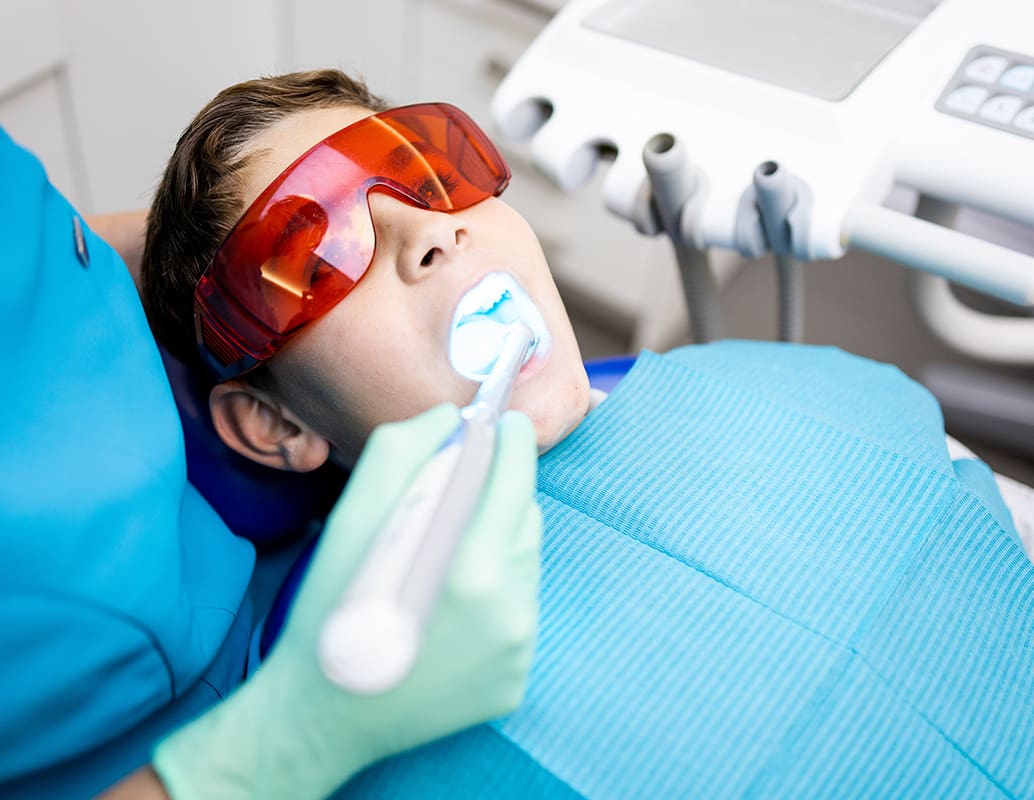Dental Bonding

About Dental Bonding
Dental bonding is a minimally invasive dental procedure that involves applying a tooth-colored resin material to the tooth and then bonding it with a special UV light.
It is considered both a restorative and a cosmetic procedure, as it can be used to fix chipped or cracked teeth or improve the appearance of teeth.
Key Takeaway
Dental bonding is a minimally invasive dental procedure that involves applying a tooth-colored resin material to teeth to improve the appearance and function. It can be used to repair chipped or cracked teeth, to close gaps or to improve the appearance of small or mishapen teeth.
Benefits of Dental Bonding
There are several advantages to choosing dental bonding over other restorative options:
- Affordability: A more affordable option compared to other procedures such as composite veneers or dental crowns.
- Quick and painless: The bonding process can typically be completed in a single visit. It also does not require any drilling or anesthesia.
- Natural-looking results: The tooth-colored resin used in dental bonding blends seamlessly with the surrounding teeth, creating a natural appearance.
- Versatility: Dental bonding can address a variety of cosmetic issues such as discoloration, gaps between teeth, or misshapen teeth. It can also be used to protect exposed roots and repair chips or cracks in the teeth.
When is Dental Bonding Recommended?
Dental bonding is not suitable for all dental problems, but it may be recommended in the following situations:
- To repair chipped or cracked teeth: Bonding can restore the shape and function of a damaged tooth.
- To close gaps between teeth: For minor spacing issues, bonding can be used to fill in the gap and create a more even smile.
- To cover discoloration: Teeth that are stained or discolored can be improved with dental bonding.
- Improves shape and size: Bonding can be used to reshape teeth that are too small or oddly shaped, creating a more symmetrical and proportionate smile.
- To protect exposed roots: Bonding can cover areas of the tooth root that have become exposed due to gum recession or other factors. This can help prevent sensitivity and further damage.
The Dental Bonding Procedure
The dental bonding process typically involves the following steps:
- Select a shade: We will use a shade guide to select a color that matches the color of your teeth.
- Tooth preparation: The surface of the tooth is roughened, and a conditioning liquid is applied.
- Bonding material application: The composite resin material, which is a putty-like resin, is applied to the tooth surface.
- Shaping: The resin is shaped to create the desired appearance, and a special light is used to harden it.
- Polishing: Once the bonding material has hardened, it is polished to match the shine of your natural teeth.
The entire procedure usually takes 30 – 60 minutes per tooth and can be completed in one visit.
Caring for Bonded Teeth
To ensure bonded teeth last as long as possible, it is important to take good care of them:
- A good oral hygiene routine is a must! Brush twice a day with a fluoride toothpaste and floss daily.
- Avoid biting or chewing on hard objects such as ice or pens, which could damage the bonding material.
- Limit consumption of stain-causing foods and drinks.
- Schedule regular checkups and cleanings to ensure the bonded teeth are in good condition and to address any issues that may arise.
FAQs About Dental Bonding
Is it expensive?
Compared to other restorative procedures, dental bonding is generally considered an affordable option. However, the cost can vary depending on the extent of treatment needed and whether any additional procedures are required.
How long does it last?
With proper care, dental bonding can last for several years. However, the bonding material is not as strong as natural tooth enamel and may need to be replaced or touched up over time.
What are the disadvantages of teeth bonding?
Some potential disadvantages of dental bonding may include:
– The bonding material is not as durable as other restorative options such as veneers or crowns.
– It can become stained or discolored over time, and the color cannot be changed once the bonding is in place.
– The bonding material may chip or break off if not cared for properly.
Are there any alternatives?
Depending on your specific dental needs, your dentist may recommend other options such as veneers or crowns for more extensive restorations. Veneers are thin shells that cover the front surface of the tooth, while crowns completely cover the entire tooth.
Can dental bonding be used on primary teeth?
Yes, dental bonding can be used on primary teeth (baby teeth). It is often recommended for children who have chipped or discolored front teeth as a temporary solution until their permanent teeth come in.
Dental bonding is an affordable way to improve the appearance of your child’s teeth. It is a quick procedure that provides great results!
If your child or teen has cracked or chipped teeth, or if they are self-conscious about the shape or size of their teeth, dental bonding may be a suitable solution.
We offer dental bonding and other restorative services to help your child achieve a healthy and beautiful smile.
If you are searching for a pediatric dentist that is accepting new patients, we can help! To book an appointment at our pediatric dental office in Overland Park, KS, call (913) 345-0331 or complete the online inquiry form.

